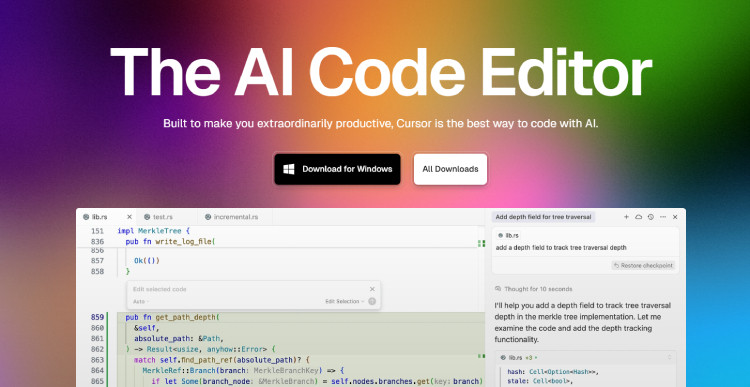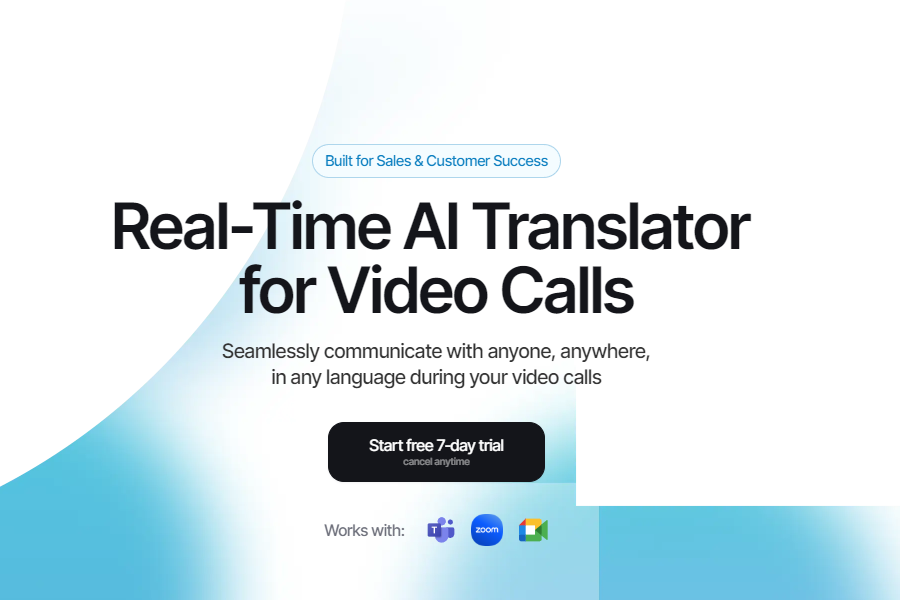
Cursor
AI Programming Tool
AI Code Editor: Rapid Programming and Software Development Tool
website:cursor.com
What’s Cursor?
Cursor is an AI-native integrated development environment (IDE) developed by Anysphere, designed to revolutionize software development by deeply integrating cutting-edge AI models (GPT-4, Claude, DeepSeek, etc.) into the coding workflow. Built as an enhanced fork of Visual Studio Code (VS Code), it retains full compatibility with VS Code’s ecosystem while supercharging it with AI-powered intelligence, enabling developers to write, debug, and optimize code faster than ever.
Cursor’s Main Features
1. Code Generation
Cursor can automatically generate functional code based on developer instructions or contextual analysis, significantly reducing time spent on boilerplate and repetitive tasks.
- Natural Language to Code: Describe what you need (e.g., “Create a REST API endpoint in Flask”), and Cursor generates the complete implementation.
- Context-Aware Suggestions: AI understands project structure, dependencies, and coding patterns to produce cohesive, style-consistent code.
- Template Expansion: Quickly scaffold components (React, Django models, SQL queries) with minimal input.
2. Intelligent Code Completion
Beyond standard autocomplete, Cursor offers predictive, context-sensitive suggestions that adapt to your project.
- Full-Line & Block Completion: Press
Tabto accept multi-line suggestions (e.g., loops, error handling). - Type-Aware Predictions: Infers variable types and function returns for higher accuracy.
- Library-Specific Help: Learns your frequently used frameworks (e.g., TensorFlow, Pandas) to prioritize relevant completions.
3. Bug Detection & Automated Fixes
Cursor’s AI acts as a real-time code reviewer, catching issues before runtime.
- Error Diagnosis: Highlights syntax/logic errors and explains root causes (e.g., “Unhandled promise rejection in line 42”).
- Fix Suggestions: Proposes one-click corrections for common bugs (null checks, async/await mismatches).
- Pattern-Based Warnings: Flags anti-patterns (e.g., memory leaks, inefficient loops) with optimization guidance.
4. Code Explanation & Learning
Demystify complex or legacy code instantly:
- Inline Documentation: Hover over code to see AI-generated summaries of functionality.
- Step-by-Step Breakdowns: Request explanations like “How does this sorting algorithm work?” for interactive learning.
- Cross-Reference Links: Identifies connections between functions/files (e.g., “This method is called in 3 other modules”).
5. Automated Documentation
Maintain up-to-date docs with zero effort:
- README Generation: Summarizes project structure, setup steps, and key features in Markdown.
- Docstring Creation: Auto-writes Python/JSdoc comments for functions, including parameter descriptions.
- Visual Flowcharts: Generates architecture diagrams from code (e.g., React component hierarchies).
6. Performance Optimization
Cursor analyzes code to boost efficiency and scalability:
- Algorithmic Improvements: Suggests faster data structures (e.g., replacing lists with sets for O(1) lookups).
- Resource Usage Tips: Warns about high CPU/memory operations (e.g., unindexed SQL queries).
- Concurrency Advice: Recommends async/threading optimizations for I/O-bound tasks.
7. Multi-Language & Framework Support
Works seamlessly across 50+ languages and ecosystems, including:
- Web: JavaScript/TypeScript (React, Vue), HTML/CSS, PHP
- Backend: Python (Django, Flask), Java, C#, Go, Rust
- Data Science: SQL, R, Jupyter Notebooks
- Mobile: Swift (iOS), Kotlin (Android)
- Config/Infra: YAML, Terraform, Dockerfiles
8. Additional AI Features
- Test Generation: Writes unit/integration tests (e.g., “Generate pytest cases for this class”).
- API Integration: Auto-creates API clients from OpenAPI specs.
- Security Scanning: Detects vulnerabilities (SQLi, XSS) and suggests hardening measures.

How To Use Cursor?
Download and Install: Visit Cursor’s official website (cursor.com) to download the installer and follow the prompts to complete the installation.
Register an Account: After launching Cursor, sign up for an account and verify your email.
Install Plugins: Install language plugins and other extensions as needed, such as a Chinese language plugin or compiler plugins for specific programming languages.
Create a New File: Open or create a new project file in Cursor and ensure the file has the correct extension.
Configure the Interpreter: If a specific language runtime is required, set up the corresponding interpreter.
Use AI Features:
- Press a shortcut key (e.g., Ctrl+K) to open the AI dialog and enter your programming request.
- The AI will generate code or provide suggestions based on your input.
Run and Test Code: Use the interface’s run button or shortcut keys to execute the code and check the output.
Review and Modify Code: If the AI-generated code does not meet expectations, manually edit it or refine the request in the AI dialog.
Ask and Learn: For any unclear code segments, use the shortcut to open the chatbox and ask the AI about the code’s functionality and logic.
Import Libraries: If specific libraries are needed, install them via the terminal or command line.
Code Management and Optimization: Use Cursor’s AI features for code review and optimization to improve code quality.
Cursor’ Pricing
Cursor currently offers three pricing tiers:
Hobby (Free Tier) – Ideal for casual users, this plan includes:
- A two-week Pro trial
- Limited Agent requests
- Restricted Tab completions
Pro ($20/month) – Designed for professional developers, adding:
- Everything in Hobby, plus:
- Higher Agent usage limits
- Unlimited Tab completions
- Background Agents access
- Bugbot (automated debugging)
- Maximum context window support
Ultra ($200/month) – For power users and teams, offering:
- All Pro features, plus:
- 20x usage limits on OpenAI/Claude/Gemini models
- Early access to new features
Each tier scales to match different development needs, from learning to enterprise-grade productivity.

What’s The Latest Version Of Cursor?
The latest version of Cursor, version 1.4.2 released on August 7, 2025, introduces several powerful enhancements including improved asynchronous task handling for better background Agent performance in long-running operations like code generation and debugging, 30% faster indexing and semantic search with reduced first-token generation time (TTFT) for large codebases.
Fully autonomous AI Agents capable of analyzing, planning and executing complex code modifications, flexible Agent control via ⌘+Enter (Mac)/Ctrl+Enter (Windows) shortcuts to interrupt or queue tasks, multi-root workspace support for simultaneous indexing of multiple code repositories, and seamless GitHub & Slack integration for direct PR and task management from browsers or mobile devices.
Who Can Benefit From Cursor?
1. Programming Beginners
Cursor serves as the perfect AI mentor for those starting their coding journey:
- Interactive Learning: Get instant explanations for any programming concept (e.g., “Explain how recursion works”).
- Error-Free Examples: Generate correct, runnable code snippets for practice (e.g., “Show me a Python function to reverse a string”).
- Step-by-Step Debugging: AI breaks down errors in simple terms and guides fixes.
- Language Transition Support: Easily switch between languages (e.g., Java → Python) with AI-assisted syntax conversion.
2. Professional Developers
Boost productivity with AI pair programming:
- Boilerplate Automation: Generate CRUD endpoints, UI components, or config files in seconds.
- Legacy Code Modernization: Refactor outdated codebases (e.g., converting callback hell to async/await).
- Cross-Team Consistency: Enforce coding standards via AI-generated style-compliant code.
- Multi-Tool Integration: Sync with Jira/Slack to turn tickets into code drafts automatically.
3. Students & Educators
Cursor enhances coding education at all levels:
- Homework Helper: Solve assignments with guided AI hints (without giving direct answers).
- Classroom Demonstrations: Live-generate examples for lectures (e.g., “Show a binary search tree visualization”).
- Automated Grading: AI checks student submissions for logic errors and suggests improvements.
- Research Accelerator: Prototype algorithms for academic papers (e.g., machine learning models).
4. Data Scientists & Analysts
From ETL to ML, streamline data workflows:
- Pandas/Numpy Shortcuts: Write complex data transformations with natural language (e.g., “Group this DataFrame by month”).
- Auto-Visualization: Generate Matplotlib/Seaborn charts from dataset descriptions.
- Model Debugging: Explain why a Random Forest classifier is underperforming and suggest hyperparameters.
- SQL Optimization: Rewrite slow queries and index recommendations.
5. Freelancers & Startup Founders
Build MVPs faster with limited resources:
- Rapid Prototyping: Turn Figma designs into React components or Flask APIs in minutes.
- Contract Work Efficiency: Meet tight deadlines by automating repetitive tasks (e.g., scraping scripts).
- Tech Stack Guidance: AI recommends optimal tools (e.g., “Should I use Firebase or Supabase for this app?”).
- Pitch-Ready Demos: Generate deployable demo code for investor presentations.
6. Additional Use Cases
- DevOps Engineers: Auto-write Terraform/Kubernetes configs from infrastructure diagrams.
- QA Testers: Create comprehensive test suites by describing edge cases.
- Technical Writers: Draft API documentation from code comments.


